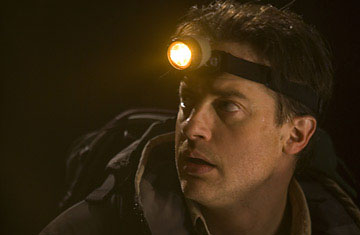
Brendan Fraser as Professor Trevor Anderson in Journey to the Center of the Earth.
Fanboys and genre mavens have been well attended to in this summer movie season, which was launched with Jon Favreau's Iron Man on May 2 and is likely to reach a climax next week with the Batman sequel The Dark Knight. Today they're lining up for Hellboy II: The Golden Army. Many in this prime demographic — 14- to 24-year-old males — have already seen Guillermo del Toro's funny freak show at one of the Thursday midnight screenings that have become obligatory for action films.
Still, that leaves a big chunk of audience: pre-teens and their parents. Now that they've had a chance to catch up with Kung Fu Panda and WALL-E, they get two PG-rated, live-action fantasies this weekend: Journey to the Center of the Earth 3D and the Eddie Murphy comedy Meet Dave.
In certain respects, they are the same movie: the adventures of fairly decent folks who literally fall into an alien world. Journey, starring Brendan Fraser, is based on the 1864 Jules Verne novel about a scientist and his accomplices who encounter a prehistoric world 4,000 miles below the Earth's surface. In Meet Dave, the travelers are extraterrestrials who have landed on Earth in search of a water supply for their parched home planet.
Just from this sketch and the stars' names, you should know if you want to see these movies or avoid them at all cost.
Stuff Jumping Out at You
The Verne story has been cinematized a dozen or more times, including a TV movie earlier this year with Rick Schroder and Peter Fonda. The one in theaters today, directed by Eric Brevig and written by Michael Weiss, Jennifer Flackett and Mark Levin, sticks pretty closely to the plot: Professor Trevor Anderson (Fraser) finds a runic inscription of an underground route inside a volcano and, with his nephew Sean (Josh Hutcherson) and an Icelandic guide (Anna Briem), locates an underworld Eden and all manner of exotic animals. And, just as in the Verne, they end up in Sicily.
It's basically a three-person saga, led by Fraser, the easygoing, Toronto-educated star of the Mummy movies; his reassuring blandness is the very definition of the word Canadian. Hutcherson, who was Will Ferrell's son in Kicking and Screaming and the older brother in Favreau's Zathura, survives the early part of the film, where he's obliged to be restless and annoying, and emerges as an acceptable young hero. The film gets a big boost from Briem, a young Icelandic actress who is both angel-cool and sorceress-hot. (She's for the target kids' older brothers.) Her role is a rare one for this sort of film: a woman as resourceful as the males, but with no agenda to humiliate them.
But neither the acting nor the story matters much here; the movie is simply the sum of its 3D effects. In recent years some upscale films, notably Robert Zemeckis' Polar Express and Beowulf, have been available in 3D. Yet for a viewer to put on those glasses, still as cumbersome a visual appliance as they were in the '50s, is to surrender to cheesiness. (I tell moviemakers who want to work in the format: get back to me when you invent 3D without specs.)
So Journey, which is emotionally sedate but determined to offer the full 3D experience, finds every excuse to send stuff jumping out at you: yoyos, rocks, dinosaur drool, the works. When Trevor spits water into the sink, you're the sink. The movie falls short only of theme-park 3D attractions, like Walt Disney World's "Honey, I Blew Up the Kids," where you get spritzed at the end. Journey also has a runaway-tram ride that will remind you of the one in Indiana Jones and the Temple of Doom, but which I'd like to think is a tribute to the roller-coaster ride in the 1953 movie This Is Cinerama (another gimmick process that premiered in the middle of the original, short-lived 3D craze).
The picture is multidimensional, all right, but not always visually persuasive. In a simple scene, say, where people talk in the foreground with shrubbery behind them, the background seems like a process shot even when it isn't; the two planes don't blend to form a plausible movie reality. The process works niftily, though, in a scene where Sean must get across a bottomless chasm by climbing from one suspended stepping stone to the next. Sometimes a gust of wind blows a stone upside down, and he must hang on, as shards of the rock break off and fall into the camera. If, at this moment, the child next to you grabs your arm and hollers "Duck!", the movie will have been worth the ticket price.
